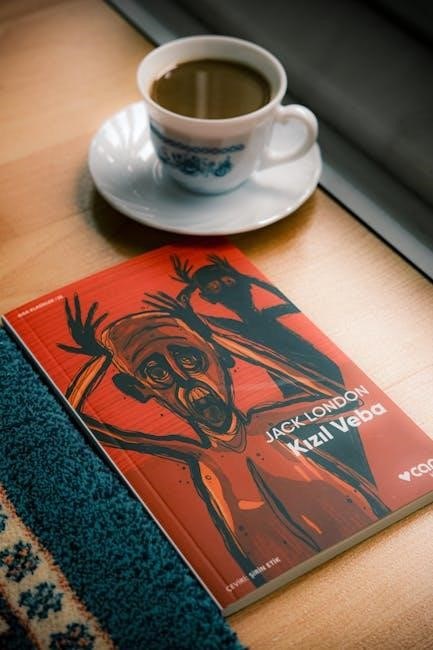Compiled from Bruce Lee’s notes, Tao of Jeet Kune Do is a seminal martial arts guide․ First published in 1975, it explores the science and philosophy behind JKD, offering insights into striking, kicking, and footwork․ This iconic book remains a cornerstone of martial arts literature, providing a detailed understanding of Lee’s revolutionary approach․ Its availability in PDF format ensures global accessibility, making it a must-read for practitioners seeking enlightenment through self-discovery and physical mastery․

Key Concepts
Jeet Kune Do emphasizes Zen enlightenment and the intercepting fist principle․ It combines efficiency and directness, focusing on practical techniques․ The book highlights Lee’s philosophy, blending science with martial arts, and features his detailed illustrations for clarity and deeper understanding․
Zen and Enlightenment
Zen philosophy is central to Jeet Kune Do, emphasizing self-discovery and mental clarity․ Bruce Lee believed that martial arts should cultivate both the body and the mind․ The book explores how Zen principles, such as simplicity and directness, apply to combat and life․ Lee advocated for abandoning rigid styles, embracing fluidity and adaptability․ This mindset fosters enlightenment, allowing practitioners to understand their true nature and unlock their full potential․ The teachings encourage a holistic approach, blending physical techniques with spiritual growth․ By integrating Zen, Jeet Kune Do becomes more than a fighting system—it’s a path to self-realization․ The PDF version of the book provides accessible insights into these profound concepts, making Lee’s wisdom available worldwide․ Through Zen, practitioners can transcend mere technique, achieving harmony and balance in their practice and daily lives․
The Intercepting Fist
The concept of the “Intercepting Fist” is a cornerstone of Jeet Kune Do, as detailed in Bruce Lee’s seminal book․ This principle emphasizes the idea of intercepting an opponent’s attack rather than waiting to react․ Lee believed that by cutting off the distance and timing, a practitioner could neutralize threats efficiently․ The PDF version of the book elaborates on this concept, showcasing how it combines speed, precision, and economy of motion․ Lee’s illustrations provide visual clarity, helping readers grasp the technique’s nuances․ The Intercepting Fist is not just a physical strategy but also a philosophical approach, reflecting JKD’s emphasis on directness and simplicity․ By mastering this concept, practitioners can achieve a higher level of combat effectiveness․ The book serves as a comprehensive guide, ensuring that Lee’s teachings remain accessible to martial artists worldwide․ Through the Intercepting Fist, JKD practitioners embody the art’s core philosophy of adaptability and efficiency․
Techniques
Jeet Kune Do encompasses a wide range of techniques, including striking, kicking, grappling, and footwork․ These methods are detailed in Bruce Lee’s book, emphasizing efficiency, balance, and adaptability․ The PDF version provides clear illustrations, ensuring mastery of JKD’s core movements․

Striking
Striking is a fundamental aspect of Jeet Kune Do, emphasizing efficiency and directness; The book details various striking techniques, including punches, palm strikes, and elbow strikes, all designed for maximum impact with minimal effort․ Bruce Lee stressed the importance of economy of motion, ensuring strikes are precise and powerful․ The PDF version of the book includes detailed illustrations, providing visual guidance for mastering these techniques․ Striking in JKD is not just about physical power but also about timing, coordination, and balance․ Lee’s approach integrates elements from boxing, Wing Chun, and other martial arts, creating a versatile striking system․ The book also explores the philosophical underpinnings of striking, linking it to self-expression and mental focus․ By studying the principles outlined in the book, practitioners can develop a comprehensive striking skill set, adaptable to various situations․ This section is a cornerstone of JKD training, offering practical and theoretical insights into the art of striking․

Kicking
Kicking is a central component of Jeet Kune Do, with the book detailing its effectiveness and versatility․ Bruce Lee emphasized that kicks are powerful tools for maintaining distance and controlling the fight․ The PDF version of the book illustrates various kicking techniques, such as front kicks, side kicks, and roundhouse kicks, each with specific applications․ Lee’s approach to kicking focuses on balance, coordination, and precision, ensuring maximum impact while minimizing vulnerability․ The book also explores the philosophical aspect of kicking, linking it to fluid movement and adaptability․ By mastering these techniques, practitioners can enhance their overall martial arts proficiency․ The detailed illustrations in the book provide clear guidance, making it easier to understand and execute the kicks effectively․ This section is essential for anyone seeking to deepen their understanding of JKD’s kicking methods and their practical applications in real-world scenarios․
Grappling
Grappling in Jeet Kune Do is explored in depth, emphasizing its role as a natural extension of striking․ The book highlights Bruce Lee’s approach to grappling as a means of controlling and neutralizing opponents through efficient techniques․ It covers essential methods such as throws, joint locks, and ground control, blending practicality with philosophical insights․ Lee’s teachings stress the importance of fluid transitions between striking and grappling, ensuring adaptability in real-world situations․ The PDF version of the book provides detailed illustrations, making it easier for practitioners to master these techniques․ Grappling in JKD is not just about physical dominance but also about understanding the opponent’s movements and exploiting weaknesses․ This section is invaluable for martial artists seeking to integrate grappling into their skill set, offering a comprehensive guide to enhancing overall combat effectiveness․ The availability of the book on platforms like Amazon and Google Books ensures widespread access to these timeless teachings․
Footwork
Footwork is a cornerstone of Jeet Kune Do, emphasized by Bruce Lee as the key to defeating any attack․ The book details four basic types of footwork: advancing, retreating, circling, and shuffling․ These movements are designed to enhance mobility, allowing practitioners to attack or evade effectively․ Lee stressed that good footwork can overcome even the most skilled techniques, making it the most important component of JKD․ The PDF version of the book provides clear illustrations, helping martial artists master these essential movements․ Footwork in JKD is not just about physical agility but also about mental awareness, ensuring practitioners stay one step ahead of their opponents․ This section is a testament to Lee’s belief in the harmony of body and mind, offering practical drills to improve agility and coordination․ The availability of the book on platforms like Amazon and Google Books makes it accessible for anyone seeking to refine their footwork and elevate their martial arts skills․
Philosophy
Bruce Lee’s Jeet Kune Do philosophy emphasizes self-discovery and personal growth․ The book explores how martial arts transcend physical techniques, focusing on mental and spiritual enlightenment․ It encourages practitioners to embrace simplicity and adaptability, reflecting Lee’s belief in the unity of body and mind․ The PDF version highlights these principles, making Lee’s teachings accessible worldwide through platforms like Amazon and Google Books․
The Science Behind JKD
The science behind Jeet Kune Do is rooted in efficiency, directness, and economy of motion․ Bruce Lee meticulously analyzed various martial arts, stripping away unnecessary techniques to create a streamlined system․ The book details how JKD combines striking, kicking, and grappling into a cohesive framework, emphasizing adaptability and practicality․ Lee’s approach focuses on understanding the underlying principles of combat, such as timing, distance, and balance, rather than rigid styles․ The PDF version of the book provides a comprehensive guide to these concepts, making it accessible to martial artists worldwide․ By blending scientific analysis with philosophical insights, JKD offers a holistic approach to martial arts, ensuring effectiveness in real-world situations․ This scientific methodology is a cornerstone of Lee’s teachings, as outlined in the Jeet Kune Do book, available on platforms like Amazon and Google Books․
The Role of Philosophy in Martial Arts

The philosophy of Jeet Kune Do transcends physical techniques, emphasizing self-discovery and personal growth․ Bruce Lee believed that martial arts should cultivate the mind, body, and spirit, fostering enlightenment through discipline and awareness․ The book highlights Zen principles, encouraging practitioners to embrace simplicity, adaptability, and spontaneity․ Lee’s teachings stress that true mastery lies in understanding oneself, as JKD is not merely a fighting system but a way of life․ The PDF version of the book delves into these philosophical underpinnings, offering insights into how martial arts can serve as a metaphor for life’s challenges․ By integrating philosophy, JKD becomes a holistic practice that empowers individuals to overcome limitations and achieve harmony․ This blend of physical and mental discipline is a testament to Lee’s vision of martial arts as a path to self-realization and inner peace․

Training Methods
Bruce Lee’s Jeet Kune Do emphasizes holistic training, blending mobility drills, conditioning, and footwork exercises․ The book outlines practical techniques to enhance agility and strength, ensuring a balanced approach to physical and mental discipline․ Effective training is key to mastering JKD․
Mobility and Footwork Drills
Bruce Lee’s Jeet Kune Do places great emphasis on mobility and footwork as foundational elements․ The book details various drills designed to enhance agility, balance, and coordination․ These exercises include advancing, retreating, circling, and shuffling, which are essential for evading attacks and maintaining offensive positioning․ Lee stressed that footwork is the cornerstone of JKD, enabling practitioners to move fluidly and strike effectively․ The drills are structured to improve overall mobility, allowing for seamless transitions between techniques․ By mastering these movements, practitioners can achieve greater control and precision in combat situations․ The PDF version of the book provides clear illustrations and descriptions, making it easier for readers to practice and integrate these drills into their training regimen․ These exercises are not only physical but also mental, fostering discipline and focus․ They are a testament to Lee’s holistic approach to martial arts, blending physical movement with philosophical insight․
Conditioning and Physical Training
Bruce Lee’s Jeet Kune Do emphasizes the importance of physical conditioning as a cornerstone of martial arts training․ The book outlines a comprehensive approach to building strength, endurance, and flexibility, ensuring practitioners are well-prepared for the demands of combat․ Lee advocates for a holistic training regimen that includes cardio, weight training, and functional exercises․ He stresses the need for adaptability, urging practitioners to tailor their conditioning to their specific needs and goals․ The PDF version of the book provides detailed workout plans and techniques, such as shadowboxing, heavy bag training, and plyometrics, to enhance power and speed․ Lee’s philosophy extends beyond physical conditioning, emphasizing mental toughness and discipline․ By combining rigorous physical training with strategic techniques, JKD practitioners can achieve peak performance․ This approach reflects Lee’s belief in continuous self-improvement and the pursuit of mastery․ The conditioning methods outlined in the book remain timeless, offering practical guidance for modern martial artists․

The Book’s Structure
The Jeet Kune Do book is structured to provide a comprehensive guide to Bruce Lee’s martial art․ It includes a detailed overview of chapters, each focusing on specific aspects of JKD, such as techniques, philosophy, and training methods․ The PDF version maintains this organization, ensuring easy navigation for readers․ Lee’s personal illustrations are integrated throughout, enhancing the understanding of key concepts․ This clear structure makes the book an invaluable resource for martial artists seeking to master JKD․
Overview of Chapters

The Jeet Kune Do book is divided into chapters that systematically explore the martial art’s core principles and techniques․ Early chapters introduce the philosophy of JKD, emphasizing Zen and self-discovery, while later sections delve into practical applications․ The PDF version retains this structure, ensuring readers can easily navigate through topics like striking, kicking, and footwork․ Each chapter builds on the previous one, creating a holistic understanding of JKD․ Bruce Lee’s personal notes and illustrations are woven throughout, providing visual and theoretical insights․ The book also covers training methods, including conditioning and mobility drills, making it a complete guide for martial artists․ Whether in physical or digital form, the structured approach of the Jeet Kune Do book ensures a deep and comprehensive learning experience․
Lee’s Illustrations
Bruce Lee’s illustrations in the Jeet Kune Do book are a vital component of the text, providing visual clarity to the martial art’s techniques and principles․ These detailed drawings, created by Lee himself, help readers understand complex movements and concepts․ The PDF version of the book preserves the quality of these illustrations, ensuring they remain accessible and clear for digital readers․ Lee’s artwork not only enhances the learning experience but also reflects his meticulous attention to detail and passion for his craft․ The illustrations cover a wide range of topics, from basic stances to advanced techniques, making the Jeet Kune Do book a comprehensive resource for martial artists․ By integrating his philosophy with visual guides, Lee’s illustrations bridge the gap between theory and practice, offering a unique and immersive learning experience․
Availability

The Jeet Kune Do book in PDF format is widely available online, offering easy access to Bruce Lee’s teachings․ Popular platforms include Amazon, Google Books, and martial arts forums, ensuring global reach and convenience for readers․
PDF Versions
The Jeet Kune Do book in PDF format is widely accessible online, offering a convenient way to explore Bruce Lee’s teachings․ This digital version ensures that the philosophy, techniques, and illustrations are preserved with clarity․ Readers can easily download the PDF from platforms like Amazon, Google Books, and martial arts forums, making it a popular choice for global access․ The PDF format allows for easy navigation and readability on various devices, ensuring that the essence of JKD is readily available to practitioners worldwide․ This digital adaptation has made Bruce Lee’s work more accessible than ever, enabling martial artists to study and apply the principles of Jeet Kune Do with ease and convenience․
The PDF version of the Jeet Kune Do book is a valuable resource for those seeking to deepen their understanding of this revolutionary martial art․ Its availability online has ensured that Bruce Lee’s legacy continues to inspire and guide martial artists across the globe․
Platforms to Access
The Jeet Kune Do book in PDF format is widely available across various platforms, making it easily accessible to martial arts enthusiasts worldwide․ Popular platforms include Amazon, Google Books, and dedicated martial arts forums․ Additionally, it can be found on platforms like eBay and other online libraries․ These platforms offer convenient access to Bruce Lee’s teachings, allowing readers to download and study the PDF version of the book․ The availability of the Jeet Kune Do book on these platforms ensures that its principles and techniques can be explored by anyone with an internet connection․ This widespread accessibility has made the PDF version a preferred choice for many martial artists seeking to deepen their understanding of JKD․ By utilizing these platforms, readers can effortlessly access and benefit from Bruce Lee’s iconic work․


No Responses